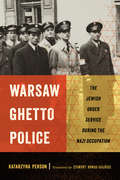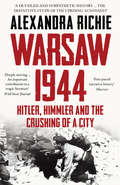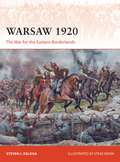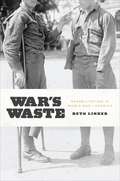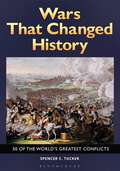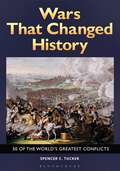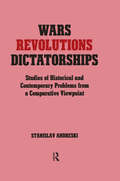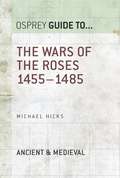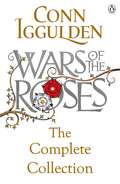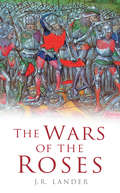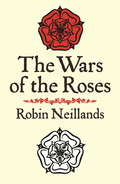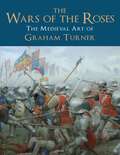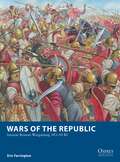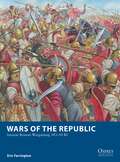- Table View
- List View
Warsaw Ghetto Police: The Jewish Order Service during the Nazi Occupation
by Katarzyna PersonIn Warsaw Ghetto Police, Katarzyna Person shines a spotlight on the lawyers, engineers, young yeshiva graduates, and sons of connected businessmen who, in the autumn of 1940, joined the newly formed Jewish Order Service.Person tracks the everyday life of policemen as their involvement with the horrors of ghetto life gradually increased. Facing and engaging with brutality, corruption, and the degradation and humiliation of their own people, these policemen found it virtually impossible to exercise individual agency. While some saw the Jewish police as fellow victims, others viewed them as a more dangerous threat than the German occupation authorities; both were held responsible for the destruction of a historically important and thriving community. Person emphasizes the complexity of the situation, the policemen's place in the network of social life in the ghetto, and the difficulty behind the choices that they made. By placing the actions of the Jewish Order Service in historical context, she explores both the decisions that its members were forced to make and the consequences of those actions.Featuring testimonies of members of the Jewish Order Service, and of others who could see them as they themselves could not, Warsaw Ghetto Police brings these impossible situations to life. It also demonstrates how a community chooses to remember those whose allegiances did not seem clear.Published in Association with the US Holocaust Memorial Museum.
Warsaw 1944: Hitler, Himmler And The Warsaw Uprising
by Alexandra RichieAs Antony Beevor cast new light on the Battle of Stalingrad, Alexandra Richie here unearths the traumatic story of one of the last major battles of World War II, in which the Poles fought off German troops, street by street, for sixty-three days.
Warsaw 1920: The War for the Eastern Borderlands (Campaign)
by Steven J. ZalogaThe Battle of Warsaw in August 1920 has been described as one of the decisive battles of European history. At the start of the battle, the Red Army appeared to be on the verge of advancing through Poland into Germany to expand the Soviet revolution. Had the war spread into Germany, another great European war would have ensued, dragging in France and Britain. However, the Red Army was defeated by 'the miracle on the Vistula'. This campaign title explores the origins and outcomes of this momentous battle. In May 1920, the Polish Army intervened in war-torn Ukraine, pushing all the way to Kiev, but the Red Army, by now triumphant in most of the theatres of the Russian Civil War, turned its attention to this new threat. By the late summer of 1920, two Soviet armies had advanced into Poland and the overconfident Soviet leadership dreamed of advancing over a prostrate Polish Army into neighbouring Germany to ignite a Communist revolution in the heart of Europe.Thanks to the low density of forces on both sides and the huge distances involved, the conflict was a war of manoeuvre, with a curious mixture of traditional and advanced tactics. Horse cavalry played a dominant role in the fighting, but aeroplanes, tanks, and armoured trains lent the war an air of modernity. This illustrated study explores the war through the lens of the Battle of Warsaw, the turning point when, after a summer of disastrous retreat, the Polish army rallied and repulsed the Red Army at Warsaw and Lwow.
Warsaw 1920: The War for the Eastern Borderlands (Campaign #349)
by Steven J. ZalogaThe Battle of Warsaw in August 1920 has been described as one of the decisive battles of European history. At the start of the battle, the Red Army appeared to be on the verge of advancing through Poland into Germany to expand the Soviet revolution. Had the war spread into Germany, another great European war would have ensued, dragging in France and Britain. However, the Red Army was defeated by 'the miracle on the Vistula'. This campaign title explores the origins and outcomes of this momentous battle. In May 1920, the Polish Army intervened in war-torn Ukraine, pushing all the way to Kiev, but the Red Army, by now triumphant in most of the theatres of the Russian Civil War, turned its attention to this new threat. By the late summer of 1920, two Soviet armies had advanced into Poland and the overconfident Soviet leadership dreamed of advancing over a prostrate Polish Army into neighbouring Germany to ignite a Communist revolution in the heart of Europe.Thanks to the low density of forces on both sides and the huge distances involved, the conflict was a war of manoeuvre, with a curious mixture of traditional and advanced tactics. Horse cavalry played a dominant role in the fighting, but aeroplanes, tanks, and armoured trains lent the war an air of modernity. This illustrated study explores the war through the lens of the Battle of Warsaw, the turning point when, after a summer of disastrous retreat, the Polish army rallied and repulsed the Red Army at Warsaw and Lwow.
War's Waste: Rehabilitation in World War I America
by Beth LinkerWith US soldiers stationed around the world and engaged in multiple conflicts, Americans will be forced for the foreseeable future to come to terms with those permanently disabled in battle. At the moment, we accept rehabilitation as the proper social and cultural response to the wounded, swiftly returning injured combatants to their civilian lives. But this was not always the case, as Beth Linker reveals in her provocative new book, War’s Waste. Linker explains how, before entering World War I, the United States sought a way to avoid the enormous cost of providing injured soldiers with pensions, which it had done since the Revolutionary War. Emboldened by their faith in the new social and medical sciences, reformers pushed rehabilitation as a means to “rebuild” disabled soldiers, relieving the nation of a monetary burden and easing the decision to enter the Great War. Linker’s narrative moves from the professional development of orthopedic surgeons and physical therapists to the curative workshops, or hospital spaces where disabled soldiers learned how to repair automobiles as well as their own artificial limbs. The story culminates in the postwar establishment of the Veterans Administration, one of the greatest legacies to come out of the First World War.
War's Waste: Rehabilitation in World War I America
by Beth LinkerWith US soldiers stationed around the world and engaged in multiple conflicts, Americans will be forced for the foreseeable future to come to terms with those permanently disabled in battle. At the moment, we accept rehabilitation as the proper social and cultural response to the wounded, swiftly returning injured combatants to their civilian lives. But this was not always the case, as Beth Linker reveals in her provocative new book, War’s Waste. Linker explains how, before entering World War I, the United States sought a way to avoid the enormous cost of providing injured soldiers with pensions, which it had done since the Revolutionary War. Emboldened by their faith in the new social and medical sciences, reformers pushed rehabilitation as a means to “rebuild” disabled soldiers, relieving the nation of a monetary burden and easing the decision to enter the Great War. Linker’s narrative moves from the professional development of orthopedic surgeons and physical therapists to the curative workshops, or hospital spaces where disabled soldiers learned how to repair automobiles as well as their own artificial limbs. The story culminates in the postwar establishment of the Veterans Administration, one of the greatest legacies to come out of the First World War.
War's Waste: Rehabilitation in World War I America
by Beth LinkerWith US soldiers stationed around the world and engaged in multiple conflicts, Americans will be forced for the foreseeable future to come to terms with those permanently disabled in battle. At the moment, we accept rehabilitation as the proper social and cultural response to the wounded, swiftly returning injured combatants to their civilian lives. But this was not always the case, as Beth Linker reveals in her provocative new book, War’s Waste. Linker explains how, before entering World War I, the United States sought a way to avoid the enormous cost of providing injured soldiers with pensions, which it had done since the Revolutionary War. Emboldened by their faith in the new social and medical sciences, reformers pushed rehabilitation as a means to “rebuild” disabled soldiers, relieving the nation of a monetary burden and easing the decision to enter the Great War. Linker’s narrative moves from the professional development of orthopedic surgeons and physical therapists to the curative workshops, or hospital spaces where disabled soldiers learned how to repair automobiles as well as their own artificial limbs. The story culminates in the postwar establishment of the Veterans Administration, one of the greatest legacies to come out of the First World War.
War's Waste: Rehabilitation in World War I America
by Beth LinkerWith US soldiers stationed around the world and engaged in multiple conflicts, Americans will be forced for the foreseeable future to come to terms with those permanently disabled in battle. At the moment, we accept rehabilitation as the proper social and cultural response to the wounded, swiftly returning injured combatants to their civilian lives. But this was not always the case, as Beth Linker reveals in her provocative new book, War’s Waste. Linker explains how, before entering World War I, the United States sought a way to avoid the enormous cost of providing injured soldiers with pensions, which it had done since the Revolutionary War. Emboldened by their faith in the new social and medical sciences, reformers pushed rehabilitation as a means to “rebuild” disabled soldiers, relieving the nation of a monetary burden and easing the decision to enter the Great War. Linker’s narrative moves from the professional development of orthopedic surgeons and physical therapists to the curative workshops, or hospital spaces where disabled soldiers learned how to repair automobiles as well as their own artificial limbs. The story culminates in the postwar establishment of the Veterans Administration, one of the greatest legacies to come out of the First World War.
War's Waste: Rehabilitation in World War I America
by Beth LinkerWith US soldiers stationed around the world and engaged in multiple conflicts, Americans will be forced for the foreseeable future to come to terms with those permanently disabled in battle. At the moment, we accept rehabilitation as the proper social and cultural response to the wounded, swiftly returning injured combatants to their civilian lives. But this was not always the case, as Beth Linker reveals in her provocative new book, War’s Waste. Linker explains how, before entering World War I, the United States sought a way to avoid the enormous cost of providing injured soldiers with pensions, which it had done since the Revolutionary War. Emboldened by their faith in the new social and medical sciences, reformers pushed rehabilitation as a means to “rebuild” disabled soldiers, relieving the nation of a monetary burden and easing the decision to enter the Great War. Linker’s narrative moves from the professional development of orthopedic surgeons and physical therapists to the curative workshops, or hospital spaces where disabled soldiers learned how to repair automobiles as well as their own artificial limbs. The story culminates in the postwar establishment of the Veterans Administration, one of the greatest legacies to come out of the First World War.
War's Waste: Rehabilitation in World War I America
by Beth LinkerWith US soldiers stationed around the world and engaged in multiple conflicts, Americans will be forced for the foreseeable future to come to terms with those permanently disabled in battle. At the moment, we accept rehabilitation as the proper social and cultural response to the wounded, swiftly returning injured combatants to their civilian lives. But this was not always the case, as Beth Linker reveals in her provocative new book, War’s Waste. Linker explains how, before entering World War I, the United States sought a way to avoid the enormous cost of providing injured soldiers with pensions, which it had done since the Revolutionary War. Emboldened by their faith in the new social and medical sciences, reformers pushed rehabilitation as a means to “rebuild” disabled soldiers, relieving the nation of a monetary burden and easing the decision to enter the Great War. Linker’s narrative moves from the professional development of orthopedic surgeons and physical therapists to the curative workshops, or hospital spaces where disabled soldiers learned how to repair automobiles as well as their own artificial limbs. The story culminates in the postwar establishment of the Veterans Administration, one of the greatest legacies to come out of the First World War.
Wars That Changed History: 50 of the World's Greatest Conflicts
by Spencer C. TuckerA thorough study of significant wars throughout history and their influence on world affairs—from the Egyptian Pharaoh Thutmore III's Campaigns during 479–459 BCE through the Iraq War of 2003–2011.For hundreds of years, wars have played a determining role in history and have decided the rise and fall of civilizations. Many believe that understanding the causes and consequences of warfare may move humankind towards world peace. This selection of the 50 most consequential wars, compiled by award-winning military historian Spencer C. Tucker, presents each conflict in chronological order and discusses its causes, its course, and its significance in world history.Through thoughtful essays and supporting visual evidence, this reference work examines the types of weapons systems employed and their effects in the field; the roles played by individual leaders such as Alexander the Great, Julius Caesar, Abraham Lincoln, and Adolf Hitler; and the impact of geography and economics on the battlefield. The work includes fascinating information about warfare, addressing subjects such as how transportation and logistics changed the face of war over time, what invention marked the ascendancy of infantry over cavalry, why World War I remains the most important war in the 20th century, and which war killed nearly half of the population of Germany. Each essay includes the latest interpretations of strategy, agendas, and consequences of the featured event.
Wars That Changed History: 50 of the World's Greatest Conflicts
by Spencer C. TuckerA thorough study of significant wars throughout history and their influence on world affairs—from the Egyptian Pharaoh Thutmore III's Campaigns during 479–459 BCE through the Iraq War of 2003–2011.For hundreds of years, wars have played a determining role in history and have decided the rise and fall of civilizations. Many believe that understanding the causes and consequences of warfare may move humankind towards world peace. This selection of the 50 most consequential wars, compiled by award-winning military historian Spencer C. Tucker, presents each conflict in chronological order and discusses its causes, its course, and its significance in world history.Through thoughtful essays and supporting visual evidence, this reference work examines the types of weapons systems employed and their effects in the field; the roles played by individual leaders such as Alexander the Great, Julius Caesar, Abraham Lincoln, and Adolf Hitler; and the impact of geography and economics on the battlefield. The work includes fascinating information about warfare, addressing subjects such as how transportation and logistics changed the face of war over time, what invention marked the ascendancy of infantry over cavalry, why World War I remains the most important war in the 20th century, and which war killed nearly half of the population of Germany. Each essay includes the latest interpretations of strategy, agendas, and consequences of the featured event.
Wars, Revolutions and Dictatorships: Studies of Historical and Contemporary Problems from a Comparative Viewpoint
by Stanislav AndreskiFirst Published in 1992. Routledge is an imprint of Taylor & Francis, an informa company. We can define war as organised fighting between groups of individuals belonging to the same species but occupying distinct territories, thus distinguishing war from fights between isolated individuals as well as from struggles between groups living intermingled within the same territory, which can be classified as rebellions, revolutions, riots and so on.The articles included in this volume were written in the 1970s and 1980s and published in very diverse journals and proceedings of conferences, in one case only in German.
Wars, Revolutions and Dictatorships: Studies of Historical and Contemporary Problems from a Comparative Viewpoint
by Stanislav AndreskiFirst Published in 1992. Routledge is an imprint of Taylor & Francis, an informa company. We can define war as organised fighting between groups of individuals belonging to the same species but occupying distinct territories, thus distinguishing war from fights between isolated individuals as well as from struggles between groups living intermingled within the same territory, which can be classified as rebellions, revolutions, riots and so on.The articles included in this volume were written in the 1970s and 1980s and published in very diverse journals and proceedings of conferences, in one case only in German.
The Wars of the Roses
by Hugh BichenoTHE REAL GAME OF THRONES... The Wars of the Roses were a prolonged brawl over an inheritance by a deeply dysfunctional extended family. The inheritance in question was the throne of England; the story is one of unbridled ambition and murderous treachery. From the 1450s, when the mentally unstable Henry VI struggled to control the violent feuding of his magnates, through the rise and fall of Richard of York, to the chaos and bloodshed of the 1470s which followed Edward IV's accession and his secret marriage to Elizabeth Woodville, this is a saga of ambition, intrigue and bloodshed. Charting a clear course through the dynastic and factional minefield of the era, and offering an authoritative analysis of the battles that ensued, Hugh Bicheno's The Wars of the Roses is a compelling one-volume account of England longest and bloodiest civil war.
The Wars of the Roses: 1455–1485 (Guide to...)
by Michael HicksThe Wars of the Roses raged from 1455 to 1485 - the longest period of civil war in English history. They barely affected the daily routine of the civilian population, yet for the leaders of the opposing houses of York and Lancaster, the wars were devastating. First hand accounts reveal how the lives of their women and children were blighted during three decades of war, as many of their male relatives met with violent deaths. This book examines in detail the causes, course and results of each of the main wars and concludes with a fascinating insight into why the wars ended so abruptly.
Wars of the Roses: Margaret Of Anjou (The\wars Of The Roses Ser. #3)
by Conn Iggulden'Iggulden is in a class of his own when it comes to epic historical fiction' Daily MirrorConn Iggulden's Wars of the Roses Ebook Bundle contain the following:TrinityStormbirdBloodlineRavenspur
The Wars of the Roses
by J R LanderThe dynastic struggles of the Wars of the Roses (1455-85) have traditionally been portrayed as belonging to one of the most dramatic periods in the history of England, an age of murder and melodrama. In this classic history of the wars, charting their origins, progress, conclusions and effects, Professor Lander sets the record straight. By putting the wars into their contemporary context, using the written records of the time (many of which are reproduced in the text) and the results of modern research and scholarship, the true picture emerges. The wars were, in fact, very limited. While not denying that contemporary English society was disorderly and violent, Lander suggests that this state of affairs was due far less to civil war than to habits of violence among all classes of society. Fluently and clearly written "The Wars of the Roses" is the perfect overview of one of the most famous of medieval conflicts. Shedding light, as it does, on fifteenth-century history as a whole, the roots of the Tudor dynasty, and the background to Shakespeare's history plays, this book deserves a place on the bookshelf of anyone interested in this most turbulent period.
The Wars of the Roses
by Robin NeillandsA concise and entertaining study of the vicious wars between the English noble houses of York and Lancaster during the 15th century.The vicious wars between the English noble houses of York and Lancaster marked the end of medieval England and the birth of the Renaissance. The end of that thirty-year period of strife and bloodshed saw the collapse of the great Plantagenet dynasty, rulers of all England and much of France for over three hundred years, and the rise of the Tudors. All the characters are here: Henry V and his luckless son, Henry VI, together with his unfortunate uncles, John of Bedford and Humphrey of Gloucester, not to mention the notorious Richard III and his nephews - The Princes in the Tower. Neillands skilfully tackles this complex period providing a clear and entertaining analysis.
The Wars of the Roses: The Medieval Art of Graham Turner
by Mr Graham TurnerA highly illustrated history of the Wars of the Roses based on the medieval art of Graham Turner.The period of civil strife in the second half of the 15th century now known as the Wars of the Roses was one of the most dramatic and tumultuous in English history. Since first being inspired by a visit to Bosworth battlefield nearly 30 years ago, renowned historical artist Graham Turner has built a worldwide reputation for his depictions of this colourful and troubled era, his paintings and prints prized by historians and collectors for their attention to detail and dramatic and atmospheric compositions. This new study contains a detailed history of the wars alongside a unique and comprehensive collection of over 120 of his paintings and drawings, many created especially for this book. It provides meticulously researched details of arms, armour, settings and countless other aspects of the period, while bringing to life the human stories behind the turbulent events.
Wars of the Republic: Ancient Roman Wargaming 343–50 BC (Osprey Wargames)
by Eric FarringtonFrom the First Samnite War and the eventual conquest of the Italian Peninsula, to the defeat by Hannibal at Lake Trasimene, and final victory over the Gauls at Alesia, Wars of the Republic is a miniature wargame that allows you to campaign with the legions or stand firm against Roman expansion and fight throughout the ancient Mediterranean. This book contains all the rules required to fight battles during this period, including multiple army lists to reflect the changing nature of the Roman military and the varied opponents they faced, be it Gaul, Italian, Carthaginian, Iberian, or Greek.
Wars of the Republic: Ancient Roman Wargaming 343–50 BC (Osprey Wargames)
by Eric FarringtonFrom the First Samnite War and the eventual conquest of the Italian Peninsula, to the defeat by Hannibal at Lake Trasimene, and final victory over the Gauls at Alesia, Wars of the Republic is a miniature wargame that allows you to campaign with the legions or stand firm against Roman expansion and fight throughout the ancient Mediterranean. This book contains all the rules required to fight battles during this period, including multiple army lists to reflect the changing nature of the Roman military and the varied opponents they faced, be it Gaul, Italian, Carthaginian, Iberian, or Greek.
The Wars Of The French Revolution And Napoleon, 1792-1815(PDF)
by Owen ConnellyWritten by an experienced author and expert in the field, Wars of the French Revolution and Napoleon, 1792-1815 provides a thorough re-examination of the crucial period in the history of France for students of history and military studies. Based on extensive research, and including twenty detailed maps, this study is unique in its focus on the wars of both the French Revolution and Napoleon. Owen Connelly expertly analyzes them both to provide a broader context for warfare. Examining the causes of the wars, and how the practices of warfare during this period were to influence mode of combat throughout the nineteenth and twentieth centuries, Connelly also establishes trends discernable in the First and Second World Wars and examines key issues including: * the impact of the population explosion on armies and war * the legacy of the ancient regime impact on revolutionary armies * the impact of the Revolution on leadership, strategy, organization and weaponry * Was Napoleon’s leadership style unique, or could another have played his role? * contributions from the governments of the early Revolution, the Terror, the Directory and the Napoleonic regime * What did twenty-three successive years of war accomplish? * Was this era a turning point in the history of warfare?
The Wars Of The French Revolution And Napoleon, 1792-1815
by Owen ConnellyWritten by an experienced author and expert in the field, Wars of the French Revolution and Napoleon, 1792-1815 provides a thorough re-examination of the crucial period in the history of France for students of history and military studies. Based on extensive research, and including twenty detailed maps, this study is unique in its focus on the wars of both the French Revolution and Napoleon. Owen Connelly expertly analyzes them both to provide a broader context for warfare. Examining the causes of the wars, and how the practices of warfare during this period were to influence mode of combat throughout the nineteenth and twentieth centuries, Connelly also establishes trends discernable in the First and Second World Wars and examines key issues including: * the impact of the population explosion on armies and war * the legacy of the ancient regime impact on revolutionary armies * the impact of the Revolution on leadership, strategy, organization and weaponry * Was Napoleon’s leadership style unique, or could another have played his role? * contributions from the governments of the early Revolution, the Terror, the Directory and the Napoleonic regime * What did twenty-three successive years of war accomplish? * Was this era a turning point in the history of warfare?
The Wars of the French Revolution and Napoleon, 1792-1815 (Warfare and History)
by Owen ConnellyWritten by an experienced author and expert in the field, Wars of the French Revolution and Napoleon, 1792-1815 provides a thorough re-examination of the crucial period in the history of France for students of history and military studies. Based on extensive research, and including twenty detailed maps, this study is unique in its focus on the wars of both the French Revolution and Napoleon. Owen Connelly expertly analyzes them both to provide a broader context for warfare. Examining the causes of the wars, and how the practices of warfare during this period were to influence mode of combat throughout the nineteenth and twentieth centuries, Connelly also establishes trends discernable in the First and Second World Wars and examines key issues including: * the impact of the population explosion on armies and war* the legacy of the ancient regime impact on revolutionary armies* the impact of the Revolution on leadership, strategy, organization and weaponry* Was Napoleon’s leadership style unique, or could another have played his role?* contributions from the governments of the early Revolution, the Terror, the Directory and the Napoleonic regime* What did twenty-three successive years of war accomplish?* Was this era a turning point in the history of warfare?
